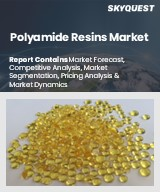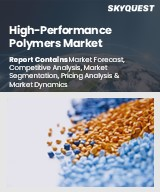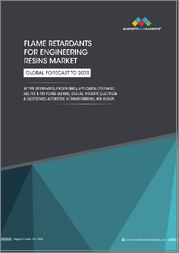
|
시장보고서
상품코드
1722636
폴리아미드 시장 보고서 : 유형, 용도, 최종 이용 산업, 지역별(2025-2033년)Polyamide Market Report by Type, Application, End Use Industry, and Region 2025-2033 |
||||||
세계 폴리아미드 시장 규모는 2024년 355억 달러에 달했습니다. 향후 IMARC Group은 2033년에는 565억 달러에 달해 2025년부터 2033년까지 5.03%의 연평균 성장률(CAGR)을 기록할 것으로 예상하고 있습니다. 자동차 산업의 수요 확대, 전기 및 전자 산업의 확대, 폴리아미드 기술의 지속적인 발전은 주로 시장 성장의 원동력이 될 것입니다.
폴리아미드(나일론)는 아미드기의 반복에 의해 연결된 분자 사슬의 반복 단위로 구성된 고성능 폴리머를 말합니다. 양모나 실크에서 자연적으로 조달할 수도 있고, 나일론, 폴리아미드6, 아라미드를 통해 합성적으로 가공할 수도 있습니다. 폴리아미드는 고온, 내구성, 내마모성, 인장 강도, 낮은 가스 투과성, 내화학성, 전기 저항의 향상 등 다양한 특성을 가지고 있습니다. 이러한 특성으로 인해 스위치, 플러그, 소켓, 펌프, 가정용 섬유 소재, 배낭, 페인트, 도료, 도장 등의 주요 부품으로 널리 사용되고 있습니다. 현재 폴리아미드는 바이오 타입과 특수 폴리아미드 타입이 시판되고 있습니다.
폴리아미드 시장 동향:
폴리아미드가 자동차 내장재, 구조 부품, 기술 부품 제조에 있어 금속보다 널리 사용되는 이유는 가볍고 안전하며 내구성이 뛰어나고 경제적인 플라스틱에 대한 요구가 높아졌기 때문으로 보입니다. 폴리아미드는 자동차 유리 강화 플라스틱 기반 구조 부품, 공기 흡입구 매니폴드, 에어백 용기, 냉각 시스템, 잠금 밸브 커버의 제조에 널리 사용되고 있으며, 이는 시장 성장을 촉진하는 주요 요인으로 작용하고 있습니다. 이와 함께 폴리아미드의 우수한 균형, 낮은 수분 흡수, 높은 내화학성 및 내열성 등 다양한 유익한 특성에 대한 인식이 높아짐에 따라 보빈, 노트북, 스마트 워치, 릴레이, 3 차원(3D) 회로 등 다양한 전자기기에 통합되는 것을 더욱 촉진하고 있습니다. 이는 또 하나의 큰 성장 촉진요인으로 작용하고 있습니다. 또한, 소비자들 사이에서 환경에 대한 인식이 높아짐에 따라 제조업체들은 연구 개발(R&D) 활동에 투자하고 특수 피마 자유 기반 바이오 폴리아미드를 도입하고 있으며, 이는 시장 성장에 기여하고 있습니다. 이와는 별도로, 포장, 기계, 섬유 및 소비재 산업에서 트레이 및 컨베이어 시스템의 차폐재로 사용되는 제품의 용도가 증가하고 있는 것도 시장 성장을 적극적으로 촉진하고 있습니다.
본 보고서에서 다루는 주요 질문
- 2024년 세계 폴리아미드 시장 규모는?
- 2025-2033년 세계 폴리아미드 시장 성장률 전망은?
- 세계 폴리아미드 시장을 이끄는 주요 요인은?
- COVID-19가 세계 폴리아미드 시장에 미치는 영향은?
- 세계 폴리아미드 시장의 유형별 분류는?
- 세계 폴리아미드 시장의 용도별 분류는?
- 세계 폴리아미드 시장을 최종 사용 산업별로 분류하면?
- 세계 폴리아미드 시장의 주요 지역은?
- 세계 폴리아미드 시장의 주요 플레이어/기업은?
목차
제1장 서문
제2장 조사 범위와 조사 방법
- 조사 목적
- 이해관계자
- 데이터 소스
- 1차 정보
- 2차 정보
- 시장 추정
- 상향식 접근
- 하향식 접근
- 조사 방법
제3장 주요 요약
제4장 소개
- 개요
- 주요 업계 동향
제5장 세계의 폴리아미드 시장
- 시장 개요
- 시장 실적
- COVID-19의 영향
- 시장 예측
제6장 시장 내역 : 유형별
- 지방족 폴리아미드
- 방향족 폴리아미드
제7장 시장 내역 : 용도별
- 섬유와 필름
- 엔지니어링 플라스틱
제8장 시장 내역 : 최종 이용 산업별
- 자동차
- 전기·전자공학
- 섬유
- 건설
- 포장
- 소비재
- 기타
제9장 시장 내역 : 지역별
- 북미
- 미국
- 캐나다
- 아시아태평양
- 중국
- 일본
- 인도
- 한국
- 호주
- 인도네시아
- 기타
- 유럽
- 독일
- 프랑스
- 영국
- 이탈리아
- 스페인
- 러시아
- 기타
- 라틴아메리카
- 브라질
- 멕시코
- 기타
- 중동 및 아프리카
- 시장 내역 : 국가별
제10장 SWOT 분석
- 개요
- 강점
- 약점
- 기회
- 위협
제11장 밸류체인 분석
제12장 Porter's Five Forces 분석
- 개요
- 구매자의 교섭력
- 공급 기업의 교섭력
- 경쟁 정도
- 신규 참여업체의 위협
- 대체품의 위협
제13장 가격 분석
제14장 경쟁 구도
- 시장 구조
- 주요 기업
- 주요 기업 개요
- Arkema S.A.
- Asahi Kasei Corporation
- BASF SE
- DuPont de Nemours Inc.
- Evonik Industries AG
- Gujarat State Fertilizers & Chemicals Limited(GSFC)
- Huntsman International LLC
- Koch Industries Inc.
- Koninklijke DSM N.V.
- Lanxess AG
- Mitsubishi Chemical Corporation
- Saudi Basic Industries Corporation(Saudi Arabian Oil Co.)
- Solvay S.A.
- Toray Industries Inc.
The global polyamide market size reached USD 35.5 Billion in 2024. Looking forward, IMARC Group expects the market to reach USD 56.5 Billion by 2033, exhibiting a growth rate (CAGR) of 5.03% during 2025-2033. The growing automotive industry demand, expanding electrical and electronics industry, and ongoing advancements in polyamide technology are primarily driving the market's growth.
Polyamide, or nylon, refers to a high-performance polymer that comprises repeated units in the molecular chain linked together by recurring amide groups. It can be procured naturally from wool and silk or can be processes synthetically through nylon, polyamide 6, and aramids. Polyamide possesses a broad range of features, such as high temperature, durability, abrasion, and tensile strength, low-gas permeability, and enhanced chemical and electrical resistance. On account of these properties, it is widely used as a key component for manufacturing switches, plugs, sockets, pumps, home textile materials, backpacks, coatings, and paintings. At present, polyamide is commercially available in bio and specialty polyamide types.
Polyamide Market Trends:
The widespread adoption of polyamide over metal across the automotive sector to produce interior, structural, and technical components of vehicles can be attributed to the increasing need for lightweight, safe, durable, and economical plastics. Polyamides are extensively employed for manufacturing glass-reinforced plastic-based structural parts, air intake manifolds, airbag containers, cooling systems, and rock valve covers in automobiles, which, in turn, represents the key factor primarily driving the market growth. In line with this, the increasing awareness regarding the various beneficial properties of polyamide, including superior balance, low water absorption, and high chemical and heat abrasion, is further facilitating its incorporation in various electronic devices, such as bobbins, laptops, smartwatches, relays, and three-dimensional (3D) circuits for fabrication purposes. This is acting as another major growth-inducing factor. Additionally, the rising environmental awareness amongst consumers has prompted manufacturers to invest in research and development (R&D) activities to introduce specialty and castor oil-based bio-polyamide, which is also contributing to the market growth. Apart from this, the increasing product application in the packaging, machinery, textiles, and consumer goods industry as a shielding material in trays and conveyer systems is positively stimulating the market growth.
Key Market Segmentation:
Breakup by Type:
- Aliphatic Polyamides
- Aromatic Polyamides
Breakup by Application:
- Polyamide Fibers and Films
- Engineering Plastics
Breakup by End Use Industry:
- Automotive
- Electrical and Electronics
- Textile
- Construction
- Packaging
- Consumer Goods
- Others
Breakup by Region:
- North America
- United States
- Canada
- Asia-Pacific
- China
- Japan
- India
- South Korea
- Australia
- Indonesia
- Others
- Europe
- Germany
- France
- United Kingdom
- Italy
- Spain
- Russia
- Others
- Latin America
- Brazil
- Mexico
- Others
- Middle East and Africa
Competitive Landscape:
The competitive landscape of the industry has also been examined along with the profiles of the key players being Arkema S.A., Asahi Kasei Corporation, BASF SE, DuPont de Nemours Inc., Evonik Industries AG, Gujarat State Fertilizers & Chemicals Limited (GSFC), Huntsman International LLC, Koch Industries Inc., Koninklijke DSM N.V., Lanxess AG, Mitsubishi Chemical Corporation, Saudi Basic Industries Corporation (Saudi Arabian Oil Co.), Solvay S.A. and Toray Industries Inc.
Key Questions Answered in This Report
- 1.What was the size of the global polyamide market in 2024?
- 2.What is the expected growth rate of the global polyamide market during 2025-2033?
- 3.What are the key factors driving the global polyamide market?
- 4.What has been the impact of COVID-19 on the global polyamide market?
- 5.What is the breakup of the global polyamide market based on the type?
- 6.What is the breakup of the global polyamide market based on the application?
- 7.What is the breakup of the global polyamide market based on end use industry?
- 8.What are the key regions in the global polyamide market?
- 9.Who are the key players/companies in the global polyamide market?
Table of Contents
1 Preface
2 Scope and Methodology
- 2.1 Objectives of the Study
- 2.2 Stakeholders
- 2.3 Data Sources
- 2.3.1 Primary Sources
- 2.3.2 Secondary Sources
- 2.4 Market Estimation
- 2.4.1 Bottom-Up Approach
- 2.4.2 Top-Down Approach
- 2.5 Forecasting Methodology
3 Executive Summary
4 Introduction
- 4.1 Overview
- 4.2 Key Industry Trends
5 Global Polyamide Market
- 5.1 Market Overview
- 5.2 Market Performance
- 5.3 Impact of COVID-19
- 5.4 Market Forecast
6 Market Breakup by Type
- 6.1 Aliphatic Polyamides
- 6.1.1 Market Trends
- 6.1.2 Market Forecast
- 6.2 Aromatic Polyamides
- 6.2.1 Market Trends
- 6.2.2 Market Forecast
7 Market Breakup by Application
- 7.1 Polyamide Fibers and Films
- 7.1.1 Market Trends
- 7.1.2 Market Forecast
- 7.2 Engineering Plastics
- 7.2.1 Market Trends
- 7.2.2 Market Forecast
8 Market Breakup by End Use Industry
- 8.1 Automotive
- 8.1.1 Market Trends
- 8.1.2 Market Forecast
- 8.2 Electrical and Electronics
- 8.2.1 Market Trends
- 8.2.2 Market Forecast
- 8.3 Textile
- 8.3.1 Market Trends
- 8.3.2 Market Forecast
- 8.4 Construction
- 8.4.1 Market Trends
- 8.4.2 Market Forecast
- 8.5 Packaging
- 8.5.1 Market Trends
- 8.5.2 Market Forecast
- 8.6 Consumer Goods
- 8.6.1 Market Trends
- 8.6.2 Market Forecast
- 8.7 Others
- 8.7.1 Market Trends
- 8.7.2 Market Forecast
9 Market Breakup by Region
- 9.1 North America
- 9.1.1 United States
- 9.1.1.1 Market Trends
- 9.1.1.2 Market Forecast
- 9.1.2 Canada
- 9.1.2.1 Market Trends
- 9.1.2.2 Market Forecast
- 9.1.1 United States
- 9.2 Asia-Pacific
- 9.2.1 China
- 9.2.1.1 Market Trends
- 9.2.1.2 Market Forecast
- 9.2.2 Japan
- 9.2.2.1 Market Trends
- 9.2.2.2 Market Forecast
- 9.2.3 India
- 9.2.3.1 Market Trends
- 9.2.3.2 Market Forecast
- 9.2.4 South Korea
- 9.2.4.1 Market Trends
- 9.2.4.2 Market Forecast
- 9.2.5 Australia
- 9.2.5.1 Market Trends
- 9.2.5.2 Market Forecast
- 9.2.6 Indonesia
- 9.2.6.1 Market Trends
- 9.2.6.2 Market Forecast
- 9.2.7 Others
- 9.2.7.1 Market Trends
- 9.2.7.2 Market Forecast
- 9.2.1 China
- 9.3 Europe
- 9.3.1 Germany
- 9.3.1.1 Market Trends
- 9.3.1.2 Market Forecast
- 9.3.2 France
- 9.3.2.1 Market Trends
- 9.3.2.2 Market Forecast
- 9.3.3 United Kingdom
- 9.3.3.1 Market Trends
- 9.3.3.2 Market Forecast
- 9.3.4 Italy
- 9.3.4.1 Market Trends
- 9.3.4.2 Market Forecast
- 9.3.5 Spain
- 9.3.5.1 Market Trends
- 9.3.5.2 Market Forecast
- 9.3.6 Russia
- 9.3.6.1 Market Trends
- 9.3.6.2 Market Forecast
- 9.3.7 Others
- 9.3.7.1 Market Trends
- 9.3.7.2 Market Forecast
- 9.3.1 Germany
- 9.4 Latin America
- 9.4.1 Brazil
- 9.4.1.1 Market Trends
- 9.4.1.2 Market Forecast
- 9.4.2 Mexico
- 9.4.2.1 Market Trends
- 9.4.2.2 Market Forecast
- 9.4.3 Others
- 9.4.3.1 Market Trends
- 9.4.3.2 Market Forecast
- 9.4.1 Brazil
- 9.5 Middle East and Africa
- 9.5.1 Market Trends
- 9.5.2 Market Breakup by Country
- 9.5.3 Market Forecast
10 SWOT Analysis
- 10.1 Overview
- 10.2 Strengths
- 10.3 Weaknesses
- 10.4 Opportunities
- 10.5 Threats
11 Value Chain Analysis
12 Porters Five Forces Analysis
- 12.1 Overview
- 12.2 Bargaining Power of Buyers
- 12.3 Bargaining Power of Suppliers
- 12.4 Degree of Competition
- 12.5 Threat of New Entrants
- 12.6 Threat of Substitutes
13 Price Analysis
14 Competitive Landscape
- 14.1 Market Structure
- 14.2 Key Players
- 14.3 Profiles of Key Players
- 14.3.1 Arkema S.A.
- 14.3.1.1 Company Overview
- 14.3.1.2 Product Portfolio
- 14.3.1.3 Financials
- 14.3.1.4 SWOT Analysis
- 14.3.2 Asahi Kasei Corporation
- 14.3.2.1 Company Overview
- 14.3.2.2 Product Portfolio
- 14.3.3 BASF SE
- 14.3.3.1 Company Overview
- 14.3.3.2 Product Portfolio
- 14.3.3.3 Financials
- 14.3.3.4 SWOT Analysis
- 14.3.4 DuPont de Nemours Inc.
- 14.3.4.1 Company Overview
- 14.3.4.2 Product Portfolio
- 14.3.4.3 Financials
- 14.3.4.4 SWOT Analysis
- 14.3.5 Evonik Industries AG
- 14.3.5.1 Company Overview
- 14.3.5.2 Product Portfolio
- 14.3.5.3 Financials
- 14.3.5.4 SWOT Analysis
- 14.3.6 Gujarat State Fertilizers & Chemicals Limited (GSFC)
- 14.3.6.1 Company Overview
- 14.3.6.2 Product Portfolio
- 14.3.6.3 Financials
- 14.3.7 Huntsman International LLC
- 14.3.7.1 Company Overview
- 14.3.7.2 Product Portfolio
- 14.3.7.3 Financials
- 14.3.7.4 SWOT Analysis
- 14.3.8 Koch Industries Inc.
- 14.3.8.1 Company Overview
- 14.3.8.2 Product Portfolio
- 14.3.8.3 SWOT Analysis
- 14.3.9 Koninklijke DSM N.V.
- 14.3.9.1 Company Overview
- 14.3.9.2 Product Portfolio
- 14.3.10 Lanxess AG
- 14.3.10.1 Company Overview
- 14.3.10.2 Product Portfolio
- 14.3.10.3 Financials
- 14.3.10.4 SWOT Analysis
- 14.3.11 Mitsubishi Chemical Corporation
- 14.3.11.1 Company Overview
- 14.3.11.2 Product Portfolio
- 14.3.12 Saudi Basic Industries Corporation (Saudi Arabian Oil Co.)
- 14.3.12.1 Company Overview
- 14.3.12.2 Product Portfolio
- 14.3.13 Solvay S.A.
- 14.3.13.1 Company Overview
- 14.3.13.2 Product Portfolio
- 14.3.14 Toray Industries Inc.
- 14.3.14.1 Company Overview
- 14.3.14.2 Product Portfolio
- 14.3.1 Arkema S.A.



















